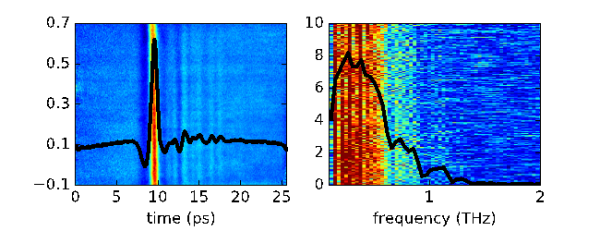Plasma Diagnostics
Our group works on developing new techniques to probe and measure the extreme, transient states that we can create in the laboratory. These allow us to understand the behavior and evolution of matter at unprecedented scales.
Ultra-fast X-ray imaging at MEC
The MEC endstation at SLAC recently commissioned their new MEC X-ray Imager (MXI) diagnostic. By looking at changes in the transmitted X-ray signal, this can visualize changes within the target on picosecond time scales and with unprecedented <200nm spatial resolution. We used these new capabilities to image the interaction of the high-intensity MEC short pulse laser with 10 μm copper wire targets. With additional Compound Refractive Lenses (CRLs) behind the target, we can observe the phase contrast of them system, increasing our sensitivity to small density variation.
Our results show the evolution of the interaction.
- At early times we see filaments forming, as precited by the current filamentation instability.
- At later times (>20 ps) we see a laser driven shock wave form, travelling at ~ 80 km/s.
- Once the shock front has passed the target rear, we observe thermal expansion of the heated region.
This is the first time that the asymmetric current-filamentation instability has been seen in a wire target. This instability is due to the high-intensity laser ionizing and accelerating a small fraction of highly energetic electrons with propagate into the wire. To maintain neutrality, this hot electron current requires a return current of cold electrons. Such counter-propagating electron populations are subject to streaming instabilities, most notably the current filamentation, or Weibel, instability. This leads to the generation of current filaments as electrons are deflected by magnetic field perturbations of the background plasma. The transverse deflection further amplifies present magnetic field modes and forms filament structures consistent with those observed in our experiment. Due to their fundamental role in plasma physics, such as laser absorption, plasma heating, electron transport, compression dynamics and resulting ion beam quality, streaming instabilities such as the current filamentation instability are of high interest to a plethora of different fields.
Given the high-density of the plasma and small spatio-temporal scales on which the instability evolves, past studies have so far almost exclusively relied on its characterization via numerical simulations and analytical models. However, while numerous theoretical and numerical efforts suggest a strong dependence of the instability on background plasma resistivity, electrostatic effects, and asymmetries in the counter-streaming electron populations, the specific dependence and associated microphysics remains poorly understood. This highlights the necessity for experimental measurements of wavelength and density perturbations associated with the instability evolution to study the instability growth and its dependence under realistic conditions.
For instance, based on the experimental observations, 2D, kinetic, PIC simulations performed by our group revealed that ion dynamics are required to preserve quasi-neutrality and allow the growth of asymmetric filaments, i.e. alternating low- and high-density regions, consistent with the experimental observations. Additionally, the target resistivity strongly increases the dominant filament wavelength. Thus, the combination of experimental results and subsequent analysis via numerical simulations and theoretical models allows to deliver a significantly improved and more complete picture of streaming instabilities by delivering 2D attenuation maps associated with the evolution of target density over time.
Single-shot THz Conductivity
Electrical conductivity is one of the important properties of warm dense matter. The theoretical description is very challenging because it contains information on electron-electron, electron-ion interactions, and electronic and ionic structures. Most measurements of electrical conductivity are often taken at optical frequencies that rely on Drude theory. To improve these experiments, we are developing a more precise method to measure the electrical conductivity at THz frequency. Our method relies on echelon-based single shot terahertz (THz, 1 THz = 1012 Hz = 1 ps-1) detection. Standard, state-of-the-art THz detection techniques require many laser pulses in order to record the THz time-domain electric field waveform, ETHz(t). Our new capability provides ETHz(t) with a single laser pulse making it possible to determine the low-frequency conductivity of warm dense matter, cf. Figure 1.

X-ray Thomson Scattering
X-ray Thomson scattering is well-established
Our group is working on a stochastic approach to take advantage of the shot-to-shot variation the spectrum of X-ray pulses delivered by XFELs such as LCLS.
Milli-electronvolt Inelastic X-ray Scattering
While X-ray Thomson Scattering probes collective modes of the electrons, our group is also working to develop even more precise approaches which can probe collective ion modes, with energies thousands of times smaller.
